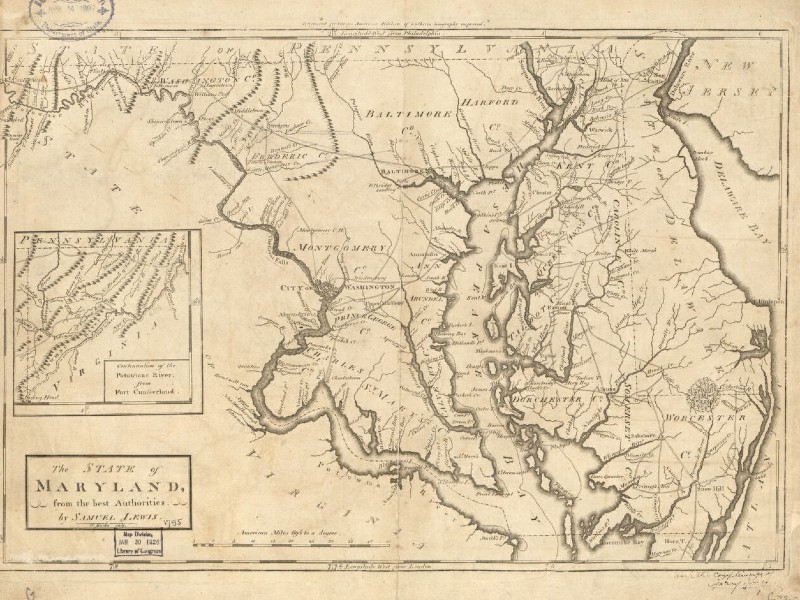Today is “Pretend to be a Time Traveler Day” and of course we wouldn’t miss the chance to bring you back in time to take a look at milestone moments in Maryland history. Come along with us as we travel from 1695 to 1952 exploring six historic events in the Old Line State.
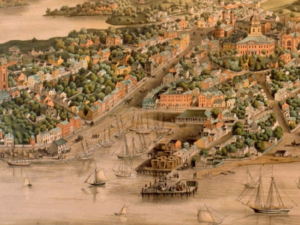
Bird’s eye view of Annapolis, 1853.
1695 – Annapolis becomes the capital of Maryland
But…before that, St. Mary’s City acted as the capital of the Maryland colony for 61 years, until the capital was moved to the more centrally-located town that we now know as Annapolis.
1776 – Four Marylanders sign the Declaration of Independence
Of the fifty-six signers of the Declaration of Independence, four men, Charles Carroll, Samuel Chase, William Paca, and Thomas Stone, represented Maryland’s interests in breaking away from Great Britain’s colonial rule and to embark on the creation of a new democratic government in America.
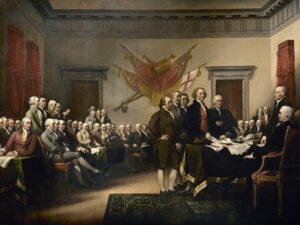
John Trumbull’s painting Declaration of Independence, depicting the five-man drafting committee of the Declaration of Independence presenting their work to the Second Continental Congress.
Due to escalations in unrest associated with British occupation and taxation of the new colonies in America, lawyers, businessmen, and those well-connected and politically-minded throughout the original thirteen colonies, all white males, established the Continental Congress. The First Continental Congress met in Philadelphia in 1774 and communicated regularly. Upon the second formal meeting of the Second Continental Congress in early July 1776, the draft Declaration of Independence was finalized and then approved on July 4, 1776.
Many Americans annually celebrate the fourth of July as Independence Day, yet the Declaration was not formally signed until a month later, including by the Maryland delegates, and the British did not surrender at Yorktown ending the Revolutionary War until 1783, a full seven years later.
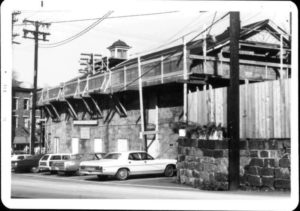
Ellicott City B&O Station, 1975. Photo from Maryland Historical Trust.
1827 – B&O Railroad Chartered by the State of Maryland
On February 28, 1827, Chapter 123 of the 1826 Session Laws of Maryland passed a law enabling the Baltimore and Ohio Railroad to be chartered as the first U.S. railway for commercial transport of passengers and freight. In addition, it was the first intercity railroad in the United States. Stakeholders in the B&O had hoped Baltimore, which was the second-largest U.S. city at the time, would successfully compete with New York for western trade.
It was not until May 24, 1830 when the first line of track opened. The track was a thirteen-mile stretch that followed the upper Patapsco and Monocacy rivers to the Potomac, ending in Ellicott’s Mills (now Ellicott City), Maryland. While it was not a long stretch by today’s standards, the track caused a lot of excitement due to the expedited travel times. However, the B&O still had skeptics because the steep, winding grades of the route were, at times, too hard for the horse-drawn coaches and wagons to handle. It wasn’t until after August 1830 that skeptics disappeared because the railroad adopted the steam-powered engine named the “Tom Thumb.”
1837 – Baltimore Sun newspaper begins publication
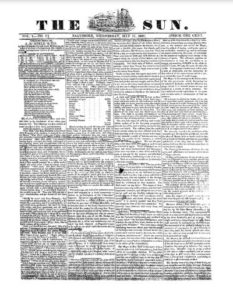
The first issue of The Baltimore Sun, 1837.
Arunah Shepherdson Abell published the first issue of The Sun from Baltimore, Maryland. A printer from Providence Rhode Island, Abell started The Sun with the hope that it would be a newspaper for all people, hence its slogan “Light for All.” Furthermore, Abell sought to make The Sun “a channel of useful information to every citizen in every department of society…whether literary, professional, mercantile, manufacturing, or miscellaneous.” The first printing was copies of a four page tabloid-size paper, circulated throughout the city, each only a penny. It is said that Abell likely set the type for this first print himself.
1850 – One year after escaping slavery in the Cambridge area, Harriett Tubman becomes a “conductor” on the Underground Railroad and rescues numerous family members and friends
Historians do not know the exact date Araminta Ross – Tubman’s given name – was born, but they estimate it was sometime between 1820 – 1822. Ross was born into slavery in Dorcester County, Md. In 1844, she entered into a marital union with a free black man named John Tubman. It was then that Ross took his last name and changed her name to Harriet, in honor of her mother.
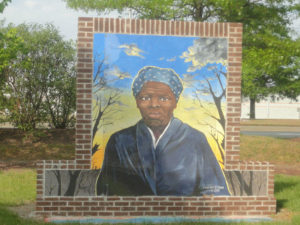
Harriet Tubman mural at her Memorial Garden in Cambridge, MD.
In 1849, Harriet Tubman escaped from slavery, eventually making her way to Philadelphia, Pa. However, as a newly free woman, she did not forget her family and friends. Tubman returned to Maryland on numerous occasions to help the rest of her family escape from slavery, using the routes on the Underground Railroad; she very quickly became an adept conductor on the railroad. Even when slave owners posted a $40,000 reward for her capture, she did not back down. It is believed that Tubman alone rescued 70 people during her lifetime.
1952 – The Chesapeake Bay Bridge opens with dual spans that link the western and eastern shores of the bay.
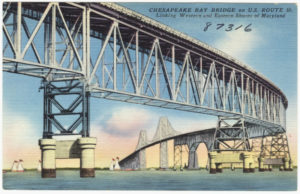
Vintage postcard of the Bay Bridge. Image from the Boston Public Library.
Ten-thousand spectators flowed in to watch the dedication of the bridge on July 30th, 1952. A car parade, led by then Governor Theodore Roosevelt McKeldin, crossed the bridge, marking its official opening. It was named after Governor William Preston Lane, who, during his time in office, had spearheaded efforts to construct the bridge. The second, westbound, span was completed in 1973.
In earlier years, the ferries could only transport a few hundred thousand cars across the Bay per year. When the Bay Bridge opened, it carried 30,000 vehicles across in the first three days! Now, it transports 20-30 million cars per year.
Trade opened up between the eastern and western shores, aiding agriculture and industry on either side, creating an economic link that unified the state like never before. The Bay Bridge earned three times the business of the ferries and paved the way for other bridges spanning the Chesapeake. Today, the only ferry that remains is the Oxford-Bellevue Ferry near St. Michael’s.

